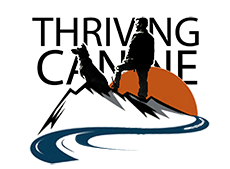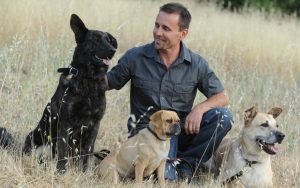 When searching for “the best way to train a dog” you will undoubtedly be confronted with conflicting information such as: “Treats Are Good” vs. “Treats Are Bad” or “Punishment Is Essential” vs. “Punishment Is Unnecessary.”
When searching for “the best way to train a dog” you will undoubtedly be confronted with conflicting information such as: “Treats Are Good” vs. “Treats Are Bad” or “Punishment Is Essential” vs. “Punishment Is Unnecessary.”
This is totally oversimplified but basically, it’s a battle over whether to train with rewards or punishments. In order to make good dog training choices, you need to ask good questions such as:
- What behavior are you training?
- What expectations do you have for this behavior?
- How important are the dog’s emotions to the process?
- How much time, money, energy, patience, etc. do you have?
The “when’s and why’s” of using rewards and punishments make much more sense with an understanding of “The Four A’s of Dog Training.” Below is a brief intro to these concepts.
#1 – Acquisition: The Learning Phase
Acquisition, the learning phase, is the period of initial training. The conditioning and associations made when acquiring new information can impact dogs on a deep level.
“You never get a second chance to make a first impression” is the phrase to keep in mind when developing a communication system, teaching a new behavior or introducing training tools. Positive reinforcement is very beneficial during the acquisition phase because it puts the dog in a cooperative state, which facilitates better learning.
Of course, everything can’t always be rainbows and butterflies. Sometimes stress or discomfort can’t be avoided but it can be minimized. Even potentially aversive tools such as head harnesses, prong collars or electric collars are subject to the acquisition phase. Aversives should be introduced in as subtle a way as possible and in balance with rewards to avoid negative fallout.
By making the learning phase as rewarding as possible, the dog will be imprinted with a passion for training. This concept applies not only to specific tasks, it can also generalize to your overall relationship with a dog. In essence, we are talking about developing the dog’s character to love learning, working and living with us.
#2 – Accuracy: The Polishing Phase
Accuracy is about increasing precision as your training progresses. For example: You’ve taught the dog to come to you but now you’d like him to sit when he gets there. Then maybe you’d like to sharpen it up a bit by having him sit a little closer to you. Then maybe get that sit perfectly straight rather than sideways. This is what trainers call “Shaping” or “Polishing.”
Competition trainers often obsess over the tiniest details but most pet dog owners don’t care much about accuracy. They just want their dogs to “listen” on some basic level. However, there are times when sloppiness causes confusion and borrowing a little accuracy from competition trainers can go a long way. Plus, it can be fun!
Accuracy can be gained through both positive and negative reinforcement but rewards help keep the dog’s spirit up, which allows for more repetitions without burnout. This is why most competition trainers have moved towards a more “Balanced” training system.
#3 – Animation: The Esthetics Phase
Animation is about esthetics and the dog’s attitude towards training. Rather than sluggishly, reluctantly or begrudgingly following commands, the animated dog performs with drive, passion and enthusiasm. Developing a dog that loves training is generally achieved through praise, treats, petting, tug, fetch and having a playful attitude yourself.
As fun as animated dog training can be, it can have a downside. Dogs trained with too much animation can become hyper, pushy, anxious, etc. This can be counterproductive for pet dog owners who generally just want their dog to be calm and obey a handful of commands.
The secret is to know whether you are looking to enhance or diminish animation in any given scenario. When training for calmness (diminished animation) you need to praise calmly rather than energetically. In some situations you don’t need to praise at all. This is where physical guidance or pressure and release tactics (aka negative reinforcement) can help balance out your dog training program.
#4 – Accountability: The Obedience Phase
Accountability is about obedience and control. This is the phase when dogs learn to be accountable for their actions and that rules and commands are non-negotiable. When a dog needs to learn the meaning of “No” or that certain behaviors are not allowed, accountability is a must. This is when a dog must learn through penalties as well as rewards.
“Traditional” dog training, which relies primarily on aversives and compulsion (aka positive-punishment and negative-reinforcement), is a proven way to achieve accountability. However, its history of extreme harshness begs the question, “At what cost to the dog’s well being?” Over the years these methods have been softened significantly and still remain effective, especially when combined with rewards, adequate exercise and fulfillment of the dog’s needs. This is called “Balanced” dog training. Even so, there is no escaping the controversy created by the “Positive” dog training movement. The question is, “Have they found a viable alternative or are they suggesting a new paradigm of lowered accountability?”
When the conversation is framed in context, we find that “Positive” (aka “Force-Free” or “Clicker”) training actually has nothing to do with accountability. It is designed to motivate dogs by giving or withholding rewards (aka positive-reinforcement and negative-punishment). There is no applied punishment, no saying “No” and no forced compliance whatsoever. Positive trainers give cues or requests, not commands. Dogs are encouraged to make choices but are not obligated to obey. So, by definition, there is no viable alternative being offered. “Positive” training is fantastic for many things but accountability is simply not one of them.
The most ethical way to train a dog for accountability is with a “Balanced” approach and an open mind. “Positive” training will minimize the need for aversive methods but, when it comes to accountability, it is a supplement not a substitute.
Summary
There is no final word on “the best way to train a dog” because the question is incomplete. The real question is, “What’s the best way to train a dog…for what?” When analyzing dog training advice, it is vital to know where the person giving the advice is coming from.
For example: They may be focused on accountability with total disregard for all the other A’s. Or, they may have no interest in accountability at all and be only concerned with accuracy and animation. Or, maybe they only train young puppies, so their advice is totally focused on acquisition.
Comparing the advice of different trainers is often apples and oranges. Hopefully The Four A’s will help make sure you are comparing apples to apples as you seek out a trainer to work with or navigate the endless sea of dog training advice. Happy Training!
-Chad Culp, Certified Dog Trainer and Canine Behavior Consultant
© Thriving Canine 2020
Related Topics:
Intrinsic Motivation in Dog Training: Beyond Carrots & Sticks
Check out www.ThrivingCanine.com for more free articles, videos and sign up for the Newsletter.
Subscribe to Thriving Canine YouTube Channel
Apply for membership of the Thriving Canine University Facebook group. (please read the rules before joining)



